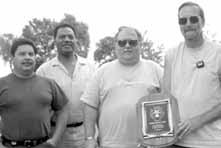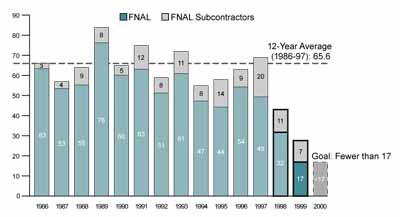|
No Accident:
Safety Record Keeps Improving
by Mike Perricone
Wayne Smith has seen a lot of changes in Fermilab since his first day on the job.
 "There was no High Rise [Wilson Hall] then," said Smith (ID 00841), a driver in the Lab's Business Services Section who marks his 30th anniversary on March 30.
"There was no High Rise [Wilson Hall] then," said Smith (ID 00841), a driver in the Lab's Business Services Section who marks his 30th anniversary on March 30.
But one of the most significant changes he's witnessed has taken place in just the last two years: a dramatic improvement in safety around the entire Lab.
"We do our jobs safely no matter what it takes," said Smith, a member of the Laboratory Safety Committee. "That feeling is Labwide now. In the past, that wasn't necessarily the case every time. Now, it's the safe way or no way."
Fermilab once again set safety records in 1999. The goal for the year was to keep the number of injuries to Fermilab employees and subcontractors below 34. The actual yearlong total was 24 (17 for employees, seven for subcontractors). That produced a lost workday case rate of 1.13, easily surpassing the Labwide goal of less than 1.6 for 1999.
 Just two years ago, the final 1997 statistics showed 69 lost workday cases. That means the1999 record represents a reduction of more than 65 percent from the 1997 level, which was even higher than the 12-year average of 65.6 during the years 1986-1997.
Just two years ago, the final 1997 statistics showed 69 lost workday cases. That means the1999 record represents a reduction of more than 65 percent from the 1997 level, which was even higher than the 12-year average of 65.6 during the years 1986-1997.
Smith and all his colleagues in Business Services won an award in June, 1999 for the most improved safety record throughout the Lab. Smith said the safety message has come through loud and clear, starting at the top levels of Lab management. He noted the safety emphasis in Director Michael Witherell's presentation during the all-hands meeting of December 1999.
"Safety isn't just a word, it's a matter of fact, every day," Smith said. "The Lab director said that, and people have taken it seriously. Lab management is getting the message out to the people."
Smith is one of 20 members of the Laboratory Safety Committee, chaired by Associate Director for Operations George Robertson, which meets monthly to provide feedback from employees around the Lab and then bring back policy directions and suggestions.
"We're seeing the positive evidence reflected in planning and hazard analysis," said safety committee secretary Bill Griffing, head of the Environment, Safety and Health Section. "The quality of those assessments is increasing. There's more willingness to do them, because people are seeing the value."
Griffing also reported a "delayed effect" in worker's compensation costs, which are beginning to decline in response to the two-year safety turnaround.
In addition to the monthly safety committee meetings, Smith described the employee meetings that have become part of the routine at Site 38, the Lab's shipping and receiving center. Any suggestions for safety measures are given to Smith to offer at the safety committee meetings.
Those suggestions carry the highest credibility, coming from the people who actually do the work. Smith cited two important examples that originated from employee suggestions:
a portable roller system to deliver the 160-plus packages arriving daily from United Parcel Service, which cut down the back injuries to employees who previously had to lift and move each package;
fold-down ladders mounted atop trucks and tractors, which cut down injuries to employees who would jump off the backs of vehicles because no ladders were handy.
Smith said the people in Business Services go beyond working with the resources at hand, developing their own ideas or examining trade magazines for new safety products.
"We try to work as a family, to help each other, and even watch out for people in other areas of the Lab, too," said Smith, who will serve on the safety committee until 2001. "It's nice to be able to have input. I hear some things firsthand, and pass them along to the committee. And I have the minutes of the committee meetings available for people here to see. We share experiences and solutions and pass them along. We call them lessons learnedˇor close calls. We try to learn from everything."
|

